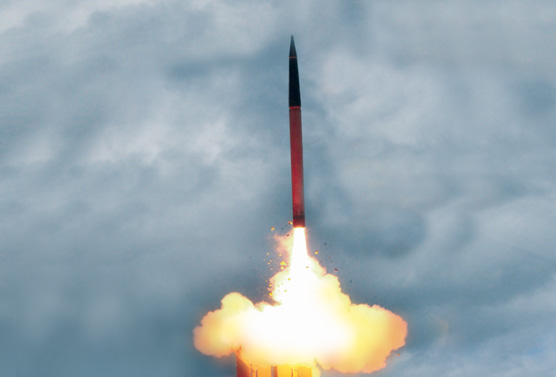
 Russian Foreign Minister Sergei Lavrov was right when he said last week that "reset" is not enough. The United States and Russia need a security cooperation software upgrade. Many issues could qualify for Sotrudnichestvo (Cooperation) 2.0, but none could do more to transform U.S.-Russia security relations than cooperation on missile defense.
Russian Foreign Minister Sergei Lavrov was right when he said last week that "reset" is not enough. The United States and Russia need a security cooperation software upgrade. Many issues could qualify for Sotrudnichestvo (Cooperation) 2.0, but none could do more to transform U.S.-Russia security relations than cooperation on missile defense.Three years after Barack Obama's administration announced revised plans for missile defense in Europe and nearly two years after the NATO-Russia Council pledged to cooperate on missile defense, two misunderstandings continue to bedevil progress. On the one hand, some Americans -- including Republican presidential candidate Mitt Romney in his Oct. 8 speech -- claim that the administration weakened George W. Bush's missile defense plans in the face of Russian complaints. For their part, Russians maintain that the current plans threaten Russia's security. Both claims are wrong and fail to understand that missile defense has to meet two requirements that at first glance look like a zero-sum Catch-22.
First, the United States wants to be able to protect itself and its allies against Iranian ballistic missiles and, potentially, nuclear weapons. Second, it sees further cuts in nuclear stockpiles -- including nonstrategic warheads, which pose a particularly high risk of proliferation -- as a national security priority. However, Russian President Vladimir Putin has declared that Russia will negotiate further cuts in nuclear stockpiles only if the United States does not deploy missile defenses that Russia fears will undermine its security. The challenge is to simultaneously defend against an Iranian nuclear missile capability without reinforcing Russian insecurity. Deploying what the administration calls the European Phased Adaptive Approach (EPAA) in cooperation with Russia is the United States' chance to do both.
One of the most persistent misunderstandings about missile defense is that the Obama administration scrapped Bush-era plans for missile defenses in Central Europe to appease Russia. In fact, the September 2009 decision was driven by the urgent need to deploy a system that works, and works soon. The four-phase EPAA is more robust, more flexible, and more effective than the previous plan, which would have been deployed only in 2017 or 2018. With 24 Standard Missile-3s deployed in Romania beginning in 2015 (Phase 2) and 24 in Poland beginning in 2018 (Phase 3, with upgraded interceptors planned for 2020 as Phase 4), the EPAA will offer more comprehensive coverage of Europe and U.S. forces deployed there than the 10 interceptors of the previous plan.
The new approach uses proven technology to provide protection first to those parts of Europe already vulnerable to Iran's current capabilities, with flexibility to upgrade the architecture as U.S. systems develop and Iran develops longer-range missiles. Elements of the EPAA will contribute to the defense of the United States from a future Iranian intercontinental ballistic missile (ICBM). And the EPAA is robust. Its distributed, mobile, and relocatable systems make missile defense assets more difficult for an adversary to target, enhancing survivability.
Recognizing its value, NATO allies unanimously agreed to this new approach at the Lisbon summit in November 2010. Obama has declared that the United States is committed to all four phases of the EPAA. Keeping true to his pledge, the United States has already deployed the first phase, with Aegis ships in the Mediterranean Sea and a land-based radar in Turkey. European missile defense is already a reality.
Appeasing Russia was not part of the calculation. Indeed, when I was briefed on the plans for EPAA in the summer of 2009, I told my colleagues in the Defense Department that I expected Russia to like EPAA even less than the previous plan, precisely because its flexibility and the larger number of interceptors would fuel nightmare scenarios in the Russian General Staff. Unfortunately, my prediction has been proved right.
The Russian General Staff argues that U.S. missile defenses in Europe will be able to intercept Russian ICBMs aimed at the United States, thereby undermining Russia's deterrent. We might ponder why -- long after Cold War confrontation is well behind us -- Russian leaders continue to put this issue at the center of their security relationship with the United States. In any event, fears that this system will negatively impact Russia's nuclear deterrent are unfounded.
The EPAA will deploy Standard Missile-3 interceptors in numbers only sufficient to thwart a few dozen ICBMs fired from Iran or another rogue actor -- nowhere near the 1,550 warheads that Russia is permitted under the New START agreement. And the Russian military is selling itself short: While these defenses are effective against crude but deadly missiles, such as those under development by Iran, U.S. defenses do not have the capability to thwart Russia's sophisticated missile technology and countermeasures. If Russian leaders really want to strike American targets, EPAA will not stop them.
Perhaps most importantly, EPAA's geographic footprint makes it effective only against missiles launched from the Middle East and the Persian Gulf region. Land-based sites in Romania and Poland cannot intercept Russian ICBMs aimed at the United States, even those ICBMs deployed at sites in western Russia, let alone Russian submarine-launched ballistic missiles. The interceptor sites are too close to Russia: By the time sensors could identify a Russian missile launch and lock in an intercept path, the Russian ICBMs would be on their way to U.S. targets with the interceptor in a futile tail-chase. It's Rocket Science 101.
Since January 2011, U.S. defense officials have met with Russian officials numerous times to explain EPAA and why it cannot neutralize Russia's strategic nuclear retaliatory capability. After about six of these meetings, I suggested to one of my Russian counterparts that we knew one another's briefings so well we could change sides of the table and give one another's presentations for a change. He liked that comment, but of course instead we dutifully took our seats on the correct sides of the table and worked through the explanations and slides once again.
In May of this year, the Russian Defense Ministry hosted an international conference at which the Russian General Staff presented briefings and technical analyses to explain its concerns. This time, the graphics in the Russian presentations were very advanced, with nifty 3-D dynamic imaging, but the basic arguments (and conclusions) were the same -- and still off the mark. The briefings attracted headlines when Gen. Nikolai Makarov, chief of the General Staff, threatened to preemptively strike missile defense sites in Europe in the event of a crisis. Entirely overlooked in the headlines, unfortunately, were detailed briefings by very senior U.S. and NATO officials explaining why EPAA cannot counter Russia's strategic capability and what NATO has proposed for a robust cooperative architecture with Russia.
Under the proposed cooperative NATO-Russia missile defense, NATO and Russia would establish an operational center at which data from each side's sensors would be fused to create a common picture. Russian radars are located in areas that would provide a direct benefit to U.S. sensors targeting the Middle East. By combining the sensor data from NATO and Russian systems, each of which provides a different angle of view when detecting incoming ballistic missiles, interceptors can be launched with greater speed and accuracy. Because ballistic missiles move so fast, seconds count.
Improving this sensor capability alone would provide an extraordinary benefit to Europe and the United States. In addition, NATO and Russia could cooperate on planning and coordinating interception of threat missiles, improving the protection of one another's territories and populations in a time of crisis. While NATO and Russia would each maintain ultimate responsibility for its own defense and control of its own interceptors, the combined capability as a result of cooperation could create a system that is more than the sum of its parts.
In addition to the concrete benefits, missile defense cooperation would provide Russia insight into how NATO's system operates and what its intentions and capabilities really are. That may be precisely why so many in Russia's security elite oppose missile defense cooperation with NATO: It would deprive them of an enemy. That insight and the security it would bring could transform the U.S.-Russia relationship from one in which the Russian leadership actively depends on the threat of retaliation for Russian security to one in which Russia focuses on real challenges, such as violent extremism and shifting power relationships throughout Asia.
Although the repeated U.S.-Russia meetings on missile defense cooperation began to feel like Dr. Strangelove meets Groundhog Day, in fact it was clear to me that we made real progress in understanding one another's technical analyses and -- perhaps more importantly -- recognizing our misunderstandings. For example, it became clear at one point that a U.S. presentation on the territory that EPAA could defend from enemy missiles (including parts of Russia) upset the Russians because they incorrectly thought the presentation showed the enemies the EPAA could defend against -- a misunderstanding that was easily corrected. Because EPAA is not capable of or intended against Russia, there is only win-win in the opportunity for military experts to work together in the cooperative structure the United States has proposed.
Finally, there is a persistent misunderstanding that the Obama administration is willing to compromise the efficacy of the system and sensitive technologies in order to secure Russian cooperation. While it is true that during discussions over the past two years, Russian officials have persistently pressed their U.S. counterparts to limit EPAA, the United States has been clear that such an option is not acceptable. Obama has made clear that an evolving threat environment and U.S. security responsibilities do not permit the United States to accept any future limitations on its missile defense systems. The goal of U.S. discussions on missile defense is to find agreement on how to act together, not how not to act.
Opponents of cooperation have suggested that the United States might provide Russia with the "hit-to-kill" technology on which missile defenses depend -- the culmination of decades of research and investment. The administration categorically denied such a scenario in testimony before the Senate Armed Services Committee in April 2011 when a senior defense official stated clearly, "We will not compromise essential technologies. There's no discussion of sharing hit-to-kill with Russia." Defense Department proposals for missile defense cooperation with Russia have been developed to ensure that sensitive technology will be neither shared nor compromised.
Effective missile defense cooperation will improve missile defenses against Iran and at the same time reassure Russia. It is the perfect security cooperation software upgrade for the "reset." There are not enough win-win opportunities in national security. We should embrace this one.
BY CELESTE WALLANDER
Celeste Wallander is an associate professor at American University's School of International Service. From May 2009 to July 2012, she served as U.S. deputy assistant secretary of defense for Russia, Ukraine, and Eurasia.
Foreign Policy










